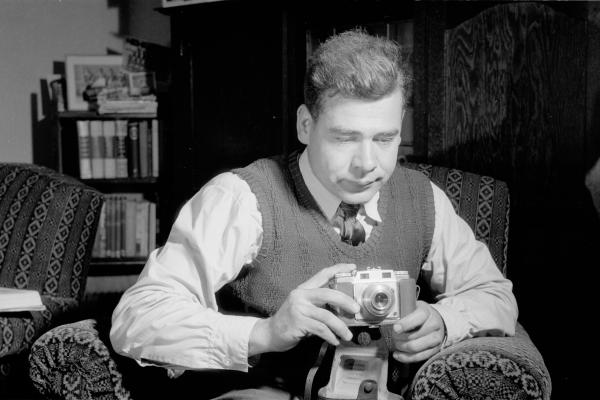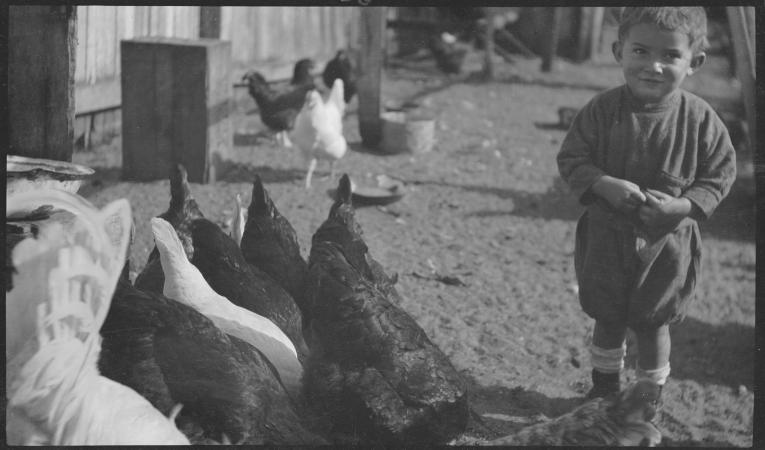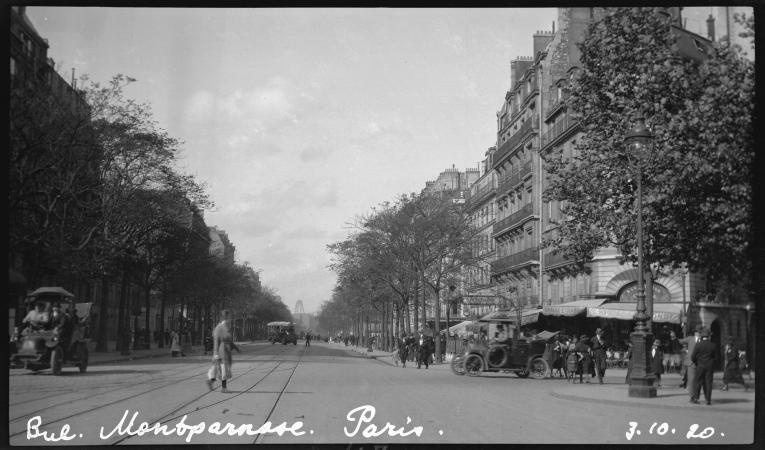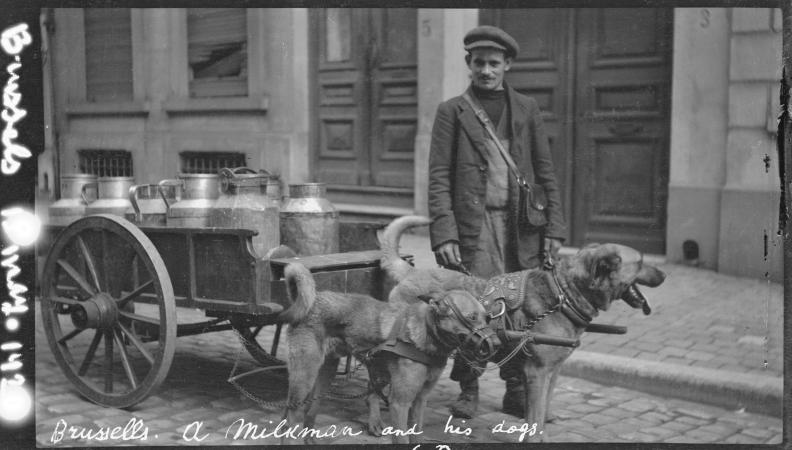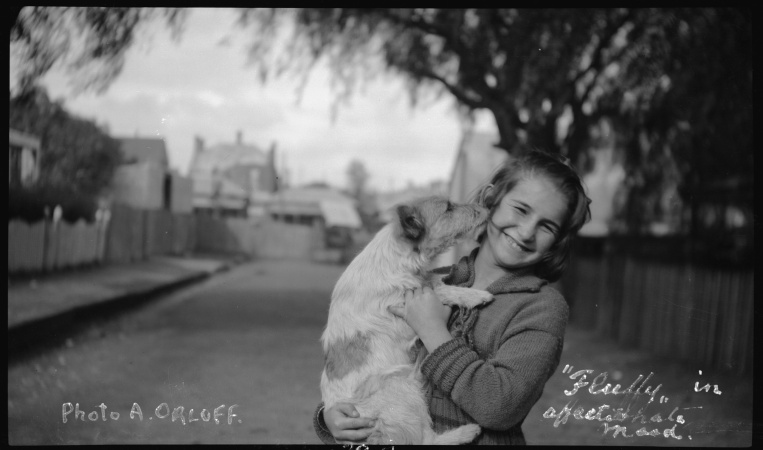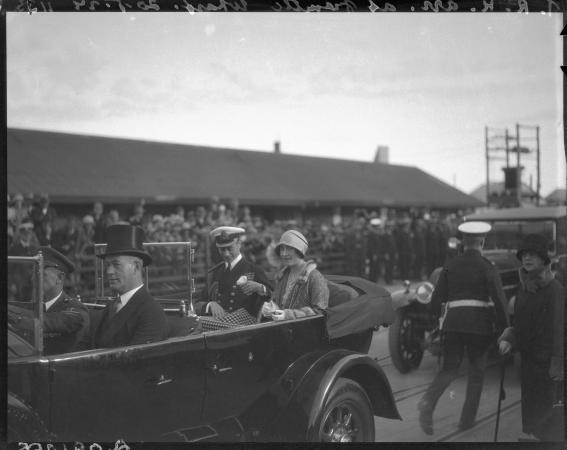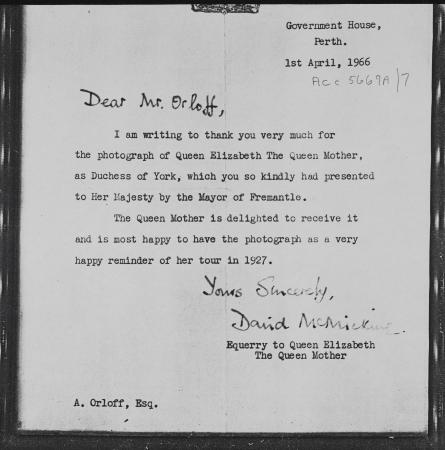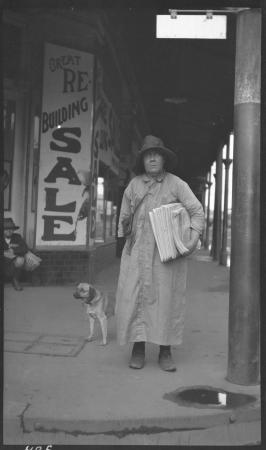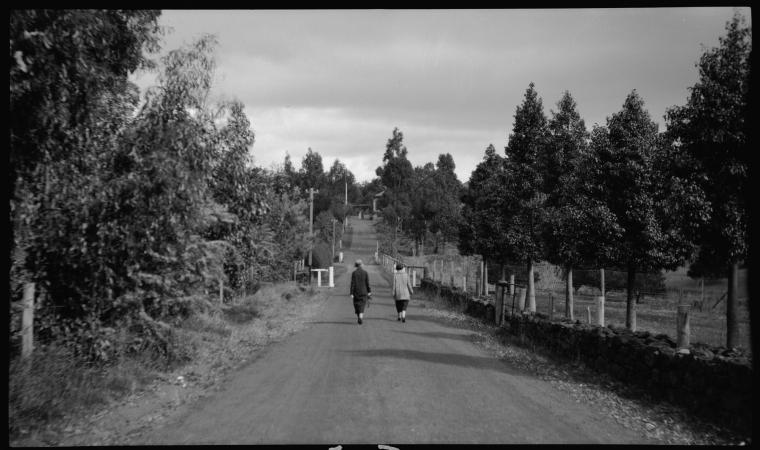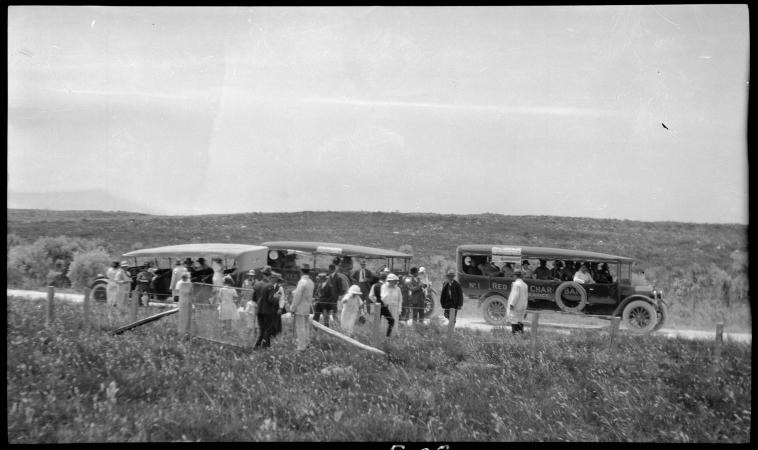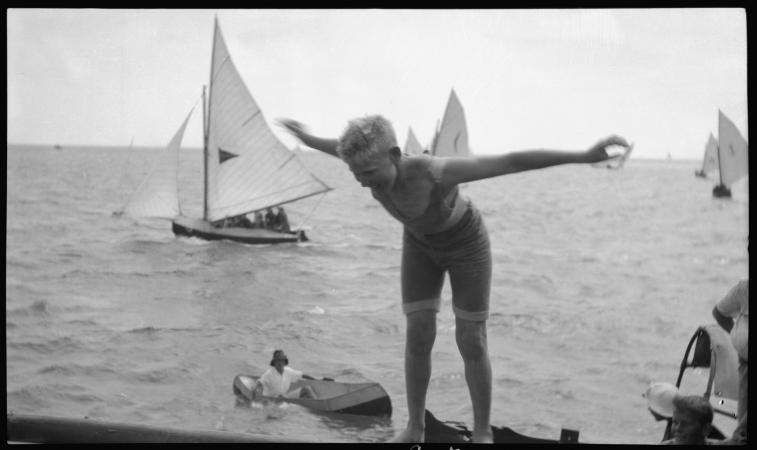
Never without a camera
Abraham 'Izzy' Orloff is one of Western Australia's most significant photographers. Born in Ukraine in 1891, he migrated to Western Australia, settling in Fremantle in 1910.
Izzy's photographs are of enduring significance in providing a pictorial record of Fremantle and Perth between the wars. His work is, however, much more than a visual record. It is also a body of artwork. Izzy can be characterised as Avant-Garde, an innovator in photographic style who captured moments in modern urban life. His focus was the streets and the people of Fremantle, Perth and beyond.
Establishing the photographic business La Tosca in Fremantle (1922), Izzy specialised in studio portraits and photo enlargements. Up until the 1950s, he had a long career working as a professional photographer. As a photographer, Izzy was prolific and talented. As an individual, he was a loved Fremantle personality who was interested in the welfare of others.
Working with a 5 x 4-inch Graphlex camera, the type favoured by sporting photographers and wartime correspondents, he produced cinematic like pictures. Izzy's Parisian training, together with natural talent, instilled in him a striking ability to simultaneously convey movement and stillness.
His outdoor photographs traverse a wide variety of subjects with recurring themes, including the beach, Fremantle ports and city streetscapes, fishing, and other forms of recreation like sailing, picnicking and football.
The collection
The Izzy Orloff collection, held at the State Library, comprises over 1,500 photographs. The collection is a small but important fraction of the pictures he captured throughout his career.
Although numerous negatives were given away or lost over time, Izzy would have amassed an enormous archive of negatives from his studio photography business. Many prints still exist hidden in family albums, clubs, and other community collections. Throughout the 1920s and 30s, Izzy sold his photographs of noteworthy events like royal and celebrity arrivals to the Sunday Times newspaper.
What is unique about the State Library’s collection is that the photographs are predominantly examples of Izzy’s outdoor photography. Going about his life and work, Izzy was ‘never without a camera’.
In 1990 Izzy’s remaining negatives were bequeathed to his great-niece, Dr Renee Hirsch, who generously donated them to State Library. Since then, many of the photographs have been digitised and are available through the catalogue; search “BA1059”.
Man in the mirror
The youngest of nine children, Abraham ‘Izzy’ Orloff (b.1891 – 1981), grew up in the village of Kaminska in Ukraine. Social and economic discrimination against Jewish people led the family to move to Palestine in 1903. Following his older brother, Aaron Orloff, Izzy migrated to Fremantle, boarding the passenger ship Nero in April 1910. Like many migrants at the time, his first job in Perth was door-to-door sales – a ‘peddler’. During the war, Izzy’s ability to translate Russian, Hebrew and Yiddish led to his employment at the Perth censorship office as an interpreter between 1917 and 1919.
After World War I, Izzy boarded the first passenger ship leaving Fremantle. Following his sister Chana Orloff, he settled in Paris. Chana worked as a sculptor and portraitist of the Parisian elite. In 1921, at age 30, Izzy received a certificate of achievement from the Portraite D’Art Photographique Felix Societe de France.
Izzy continued his travels abroad before returning to Fremantle. Initially, working for Dease Studio before establishing his own business La Tosca in Victoria Ave and later in High Street. Aged 38, he married Minnie Rose in 1929. Working as a studio and press photographer until the mid-1950s, his interest in social welfare led him to become a Justice of the Peace. Survived by his wife, Izzy passed away on 2 June 1981 and was buried at Karrakatta cemetery.
First photographs
We don’t know exactly when Izzy first picked up a camera. The earliest annotations on Izzy’s photographs in the State Library collection are from 1918, when he was about 27 years old. He was likely photographing well before this time, with box cameras increasingly available in Australia from the 1900s.
Izzy’s capture of the women’s football match at the WACA (112220PD) is one of the earliest pictorial records of women’s Australian rules football and one of his earliest photographs in the collection. The first women’s AFL matches were charity matches, often as fundraisers for the war effort or preceding the men's game. Dressed in long skirts and stockings, amused spectators watch as skirts and wide brim hats fly. Izzy captured the anticipation and dramatic momentum as women in full-length dresses leap and huddle to take the mark.
Izzy was a lover of Australian rules. Relatives Dr Renee and Mervyn Hirsch recall he was an avid East Perth football fan, repeatedly returning to ovals to capture games, team pictures and special events.
Early portraits
Many of Izzy’s early photographs from 1919 were portraits of family and friends, particularly of the nieces and nephews of older brother Aaron.
Peace Night and the end of war
On 19 July 1919, countries across the British Empire celebrated Peace Day and Peace Night, marking the end of the First World War. In Perth, the occasion was celebrated with illuminations. City buildings lit up, decorated in bright lights, a sign of optimism to break the end of five long years of ‘the war to end all wars’. Izzy captured the event and the crowds flocking the streets. 1919 was not only a big year for the world; it was an eventful year for Izzy. The following month he travelled to Melbourne on the newly built-trans Australia railway, taking photographs along the way.
Going abroad
Later in August, Izzy boarded the S.S. Ormonde, the first passenger ship to sail from Fremantle, after the war, bound for Europe. He captured the journey by documenting passengers and life onboard, repeating the process on his return to Fremantle in 1921.
Parisian life
In Europe, he followed his sister Chana Orloff, who had settled in Paris years earlier and established herself as a prominent sculptor and portraitist of the Parisian elite.
Following World War I, Paris’ literary and artistic cultures flourished as artists from all over the world descended on the city. There Izzy trained in photography and worked with Photo Felix, a pioneering fashion photographic studio, achieving a certificate in photography.
His sisters Chana’s home in Paris was described as an ‘Israeli colony of artists’, a hub for creatives of the Parisian Avant-Garde. Izzy was exposed to Avant-Garde art through his sister Chana’s associations with modernists, including Pablo Picasso, Marc Chagall and Max Jacobs. Artists of the Parisian ‘Avant Garde’ experimented with modernist art and Cubist, Surrealist and Expressionist techniques.
The experimentation happening in modern art extended to photography. There was a movement to disrupt traditional photographic conventions and focus on capturing modern life. For many, including Izzy, modern life meant photographing the streets. Izzy’s pictures of Parisian swimming pools and recreational rowing from this time prefigure his enduring interest: the beach.
Chana’s studio is likely pictured in Izzy’s photograph of Chana’s young son Alex on a rocking horse. Note the modernist sculptures shown in the background.
A modern street photographer
Modern photography was shaped by the concept of the ‘decisive moment’. First theorised by Herni Cartier-Bresson (1952), the decisive moment in photography is a split second or even a fraction of a second that could capture the significance of an event.
Before this concept was formally theorised, early street photographers like Orloff effectively captured ‘decisive moments’. Izzy’s pictures could be compared to the work of modernists like Cartier-Bresson and Eugene Atget.
Travel - extraordinary and the everyday
Izzy photographed both everyday and extraordinary moments with astounding historical detail. His photographs have undeniable emotive quality. His attunement to human feeling enabled him to capture subtle expressions or gestures, providing a window into the world of the people we see through his lens.
Abroad, Izzy experimented with his style, travelling to London, Brussels, Port Said, Colombo and beyond. Before returning to Fremantle, he photographed Jaffa, one of his childhood homes.
These photographs highlight Izzy’s emerging style: seeking striking lines in his compositions, emphasising movement and the action of his subjects with attention to conveying the emotion of the moment.
Strong lines of the jumper’s body accentuate movement in the photograph of sports at Mikveh; a woman in Jaffa stares straight at the camera, laying bare emotional vulnerability.
Return to Fremantle - Formative years
Returning to Perth in November 1921, Izzy worked for Dease, a portraiture studio, before establishing his own business, La Tosca, in North Fremantle in 1922. La Tosca specialised in studio portraits for families, individuals and groups, as well as weddings and special occasions.
The studio regularly published advertisements in The Sunday Times from the mid-1920s to the 1930s.
"Mr A. Orloff will supply your photographic needs. He is an expert who has had considerable experience in many countries" and "Call on A. Orloff about anything photographic".
Going about his community and recreational life, Izzy Orloff was never without a camera. He was regularly called upon to photograph community and family occasions. Izzy's passion for photography is conveyed through his ability to capture the mood and expression of his subjects.
Seen through the joy of his niece, Sylvia Orloff, as she cuddles 'Fluffy in an Affectionate Mood'; the pride of Mr Morris standing in front of his car outside the synagogue; and the pleasure on Izzy's face whilst presenting his 'catch' to the camera.
Relatives Dr Renee and Dr Mervin Hirsch recall memories of Izzy's passion for fishing and taking them for fishing trips on his boat, the Mineh.
Each of Izzy's outdoor photographs has a distinctive setting with Fremantle's Port, sites and streets prominently pictured in the background.
Streets of Fremantle - Portrait of the Port
Fremantle Port was a place of constant activity, movement and contrasts. His photographs depict departing naval crews alongside crowded passenger boat arrivals. As the cosmopolitan centre of the 1920s and 1930s, the Port was where news broke, workers undertook strenuous labour, and affluently dressed tourists disembarked alongside optimistic new migrants.
Izzy spent a lot of time at Fremantle Port capturing newsworthy events, offering many of his photos to The Sunday Times. The newspaper used a countless number of his pictures, on the front page, throughout the 1920s and 30s.
Streets of Fremantle - Arrivals and departures
In recalling the significant events he photographed Izzy explained, "the best lot of photos was on the wharf when the King and Queen [The Duke of York] came, I had good results. Sunday Times wanted to send their own men. I asked one of the customs men, ‘do you mind if I climb up on your roof?, I want to take some photos.’ I was able to get a better shot than the Sunday Times man because I was able to get on the roof…they made me an official photographer [for Fremantle]". Izzy later received a letter of thanks from Government House for his photographs of the occasion.
Port personality but mostly patient photographer, Izzy photographed the ships but also the arrival of people, for identity purposes. Interest in the social welfare of others led Izzy to offer his assistance in communicating with new migrants. Knowing Russian, Hebrew and Yiddish, Izzy assisted numerous Jewish, Italian, Greek and Yugoslav people who arrived in Fremantle after the war.
Fremantle flaneur
Flaneur; a French term meaning ‘stroller’ used by 19th-century poet Charles Baudelaire to identify an observer of modern urban life.
Izzy’s observation of Fremantle streets and life could rightfully earn him the title of Fremantle’s first flaneur, or urban street photographer. Always carrying his camera, Izzy was well versed in ‘people watching’.
He observed and photographed leisure activities: people bathing, groups picnicking, as well as folk enjoying outings and day trips. Izzy himself loved sailing and chess, leisure pursuits historically reserved for the more ‘well-to-do’ classes.
Izzy was acutely aware that everyone did not enjoy the privilege of leisurely modern life at the time. He did not shy away from depicting some of the inequalities and class differences present in modern urban life.
Day tripping
Outings and picnics were popular pastimes, with opportunities to visit wildflowers, waterfalls and seaside locations. In the 1920s, Mandurah, Rockingham, Mundaring and Serpentine were all day trips away from Perth. Izzy photographed sporting club outings, plus his own family’s leisure trips. Many travellers used charter bus services like Red Reos, while more affluent people could afford their own car. A sign of his growing success, in 1928 Izzy purchased a single seater Morris Cowley, with a dickie seat at the back.
Master of atmosphere
A master of atmosphere through his use of lighting effects (another Avant-Garde feature), Izzy worked with natural lighting and reflections to create strong perspective and depth. Notice the reflection of the sky in the tram's windows or the optical illusion of the water in the Cliff street flood. Izzy Orloff was anticipating and capturing these ephemeral, unique and spontaneous moments ahead of his time.
The streets - Izzy’s beach
The beach was a focus of recreational and urban life in Fremantle and a thriving hub of activity.
Bathers trick-dive, race, strike a pose and play games in Izzy’s photographs. Like the Port, the beach and river shore were places of work where lifesavers practise drills and navy personnel test dive equipment.
From the 1920s, the popular South Beach was where the action was, with acrobatics, swimming, sunbaking, hydrodome dancing and theme park attractions. Beaches including Cottesloe, Wadjemup (Rottnest) bays, the river foreshore and Como Jetty were characterised with similar exuberance when photographed by Izzy.
Izzy’s images are cinematic. A boy balances suspensefully on the edge of a pylon, and cascading divers fall through the sky in a fluid motion. Viewers can almost visualise the subsequent frames of movement, like in a film. These photographs highlight the Avant-Garde tendencies in Izzy’s work. His extensive use of wide-open spaces such as skies and oceans to frame drama shows the unusual horizon lines and angles above and below.
Yours sincerely
The Izzy Orloff collection leaves us with a rich pictorial legacy of life in Fremantle, Perth and beyond. Izzy’s work provides undeniable documentation of 20th century Perth and Fremantle between the wars as cosmopolitan places full of social activity, leisure and exuberance. Izzy’s photographs do not attempt to hide the class differences and social stratification that existed in his society, at times drawing attention to the plight and experiences of people who experienced marginalisation.
In style and composition, Izzy’s work provides a Western Australian insight into the 20th century modernist turn in photography, which moved photography beyond the studio to capture modern life, candid, in motion, through the streets—making his photographic archive even more important and influential than previously understood.
You may also be interested in...

